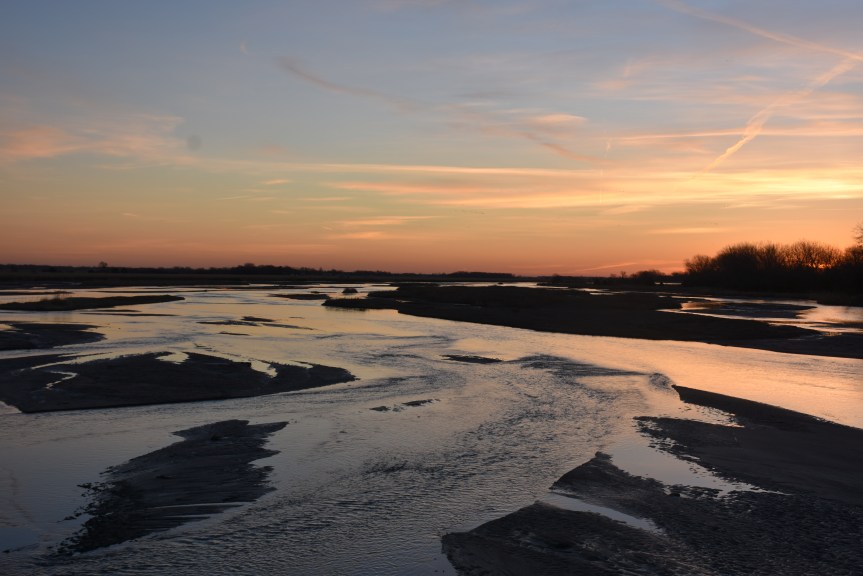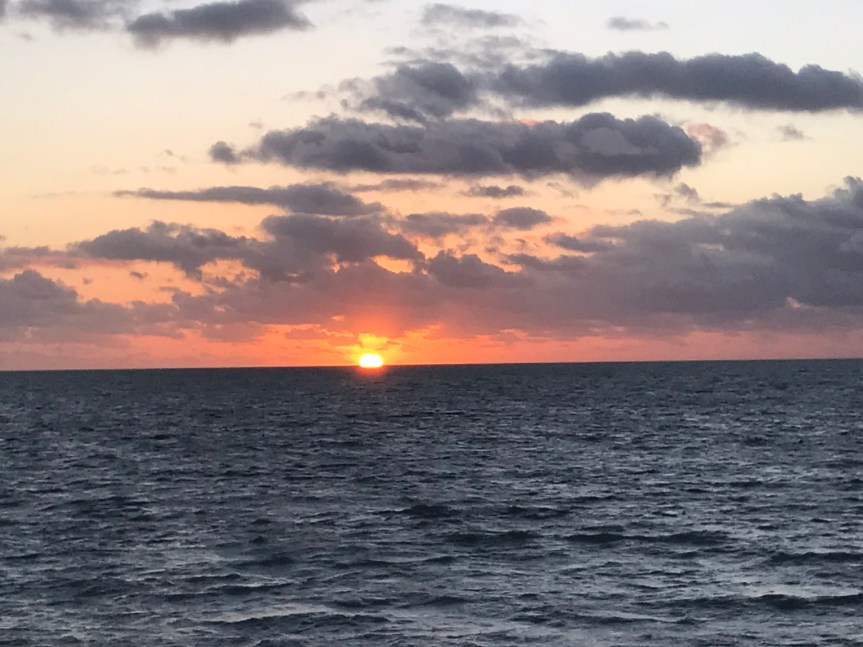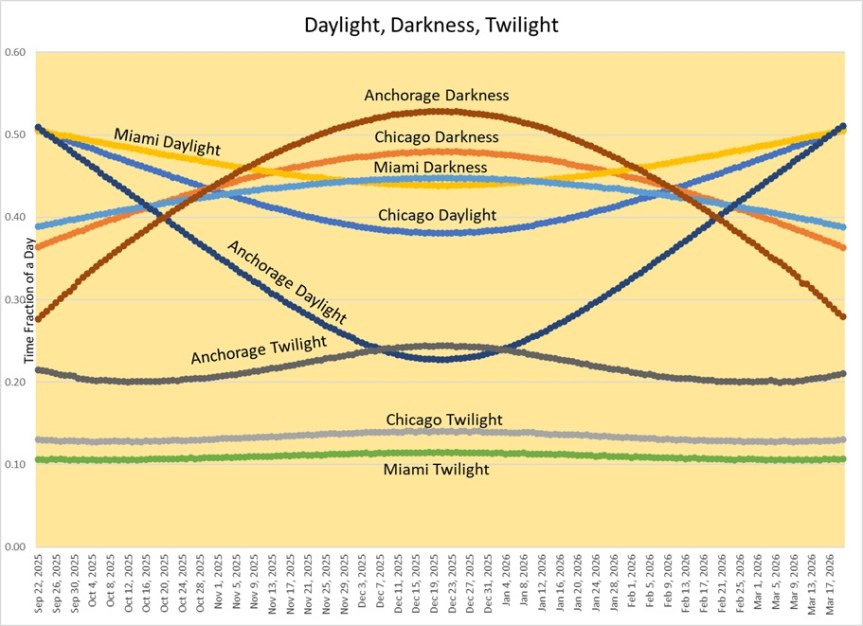October 30, 2025: Darkness grows longer than daylight as autumn progresses. Explore how daylight, twilight, and darkness change from Anchorage to Miami and mark the season’s long nights ahead.
 Photo Caption – 2022, March 16: Sunrise Approaches
Photo Caption – 2022, March 16: Sunrise Approaches
by Jeffrey L. Hunt
Chicago, Illinois: Sunrise, 7:21 a.m. CDT; Sunset, 5:47 p.m. CDT. Times are calculated by the US Naval Observatory’s MICA computer program. Check local sources for sunrise and sunset times.
Related Articles
Venus Summary Article
Changing Light Patterns
Holidays, birthdays, anniversaries, specific months, equinoxes, and solstices mark how individuals track the seasons. The autumn equinox opens the gateway to decreasing daylight and increasing nighttime.
 Photo Caption – 2022, February 2: Sunrise
Photo Caption – 2022, February 2: Sunrise
There is another way to consider the lighting effects of the changing seasons — by comparing when darkness lasts longer than daylight. Each 24-hour period divides naturally into daytime and nighttime. Simply, when the sun is above the horizon, it’s day; when it’s below, it’s night.
Nighttime itself can be split into twilight and darkness. During twilight, sunlight shines on the upper atmosphere, producing colorful displays before sunrise and after sunset. At Chicago’s latitude, each twilight lasts about 90 minutes to two hours, longer farther north and shorter toward the southern United States.
 Chart Caption – 2025-2026: This chart shows the lengths for daylight, darkness, and twilight for Anchorage, Chicago, and Miami. The vertical scale shows a decimal fraction of a 24-hour day.
Chart Caption – 2025-2026: This chart shows the lengths for daylight, darkness, and twilight for Anchorage, Chicago, and Miami. The vertical scale shows a decimal fraction of a 24-hour day.
Without twilight, darkness takes over — the sky reaches its natural blackness. Today at Chicago’s latitude, daylight and darkness are equal: 10 hours, 26 minutes. Do not confuse this with the equinox, when daylight and nighttime are nearly equal at 12 hours.
Beginning tomorrow and continuing through February 10, 2026, darkness is longer than daylight. For 103 days, there is simply no daylight to save — especially when considering year-round daylight time.
At this season, daylight is like a child’s blanket on an adult’s bed — too short to cover the feet and the shoulders at the same time.
Comparing Cities
The duration of long darkness varies by latitude. In Miami, Florida, this period lasts 41 days, from November 30, when daylight is 10 hours, 39 minutes, through January 10.
In Anchorage, Alaska, long darkness began October 20 and ends February 21, a span of 124 days. Darkness equals daylight there at 9 hours, 35 minutes, shrinking to 5 hours, 27 minutes at the winter solstice.
The accompanying chart shows the lengths of daylight, darkness, and twilight for Anchorage, Chicago, and Miami from the autumn equinox (September 22) to the vernal equinox (March 20). The points where the daylight and darkness lines intersect mark where they are equal for each city.
LATEST ARTICLES
 2025, October 30: When Darkness Overtakes Daylight: Comparing Anchorage, Chicago, and Miami
2025, October 30: When Darkness Overtakes Daylight: Comparing Anchorage, Chicago, and Miami
October 30, 2025: Darkness grows longer than daylight as autumn progresses. Explore how daylight, twilight, and darkness change from Anchorage to Miami and mark the season’s long nights ahead.
 2025, October 29: Mercury’s Greatest Elongation: The Elusive Planet Hugs the Sun’s Glare
2025, October 29: Mercury’s Greatest Elongation: The Elusive Planet Hugs the Sun’s Glare
October 29, 2025: Mercury reaches greatest elongation, appearing farthest from the sun in our sky. From mid-northern latitudes, it remains a difficult target, clinging to the bright evening twilight before passing between Earth and the sun on November 20th.
 2025, October 28: Venus, Jupiter, Saturn and First Quarter Moon
2025, October 28: Venus, Jupiter, Saturn and First Quarter Moon
October 28, 2025: Three bright planets — Venus, Jupiter, and Saturn — join the waxing moon in this week’s sky. Find viewing times for all major planets, including Uranus near the Pleiades and Neptune near Saturn, with details for Chicago’s latitude.
 2025, October 27: Visibilities of Planets and Moon
2025, October 27: Visibilities of Planets and Moon
October 27, 2025: Venus, Jupiter, Saturn, and the moon are visible during the night. Use a binocular to see the moon with Sagittarius after sunset.
 2025, October 26: Arcturus Before Sunrise and After Sunset: Seasonal Star Patterns
2025, October 26: Arcturus Before Sunrise and After Sunset: Seasonal Star Patterns
October 26. 2025: At this season, Arcturus appears before sunrise and after sunset, while the moon shines near Sagittarius. Learn how bright stars like Arcturus, Vega, and Capella trace long paths near the circumpolar region.
Like this:
Like Loading…
Related
